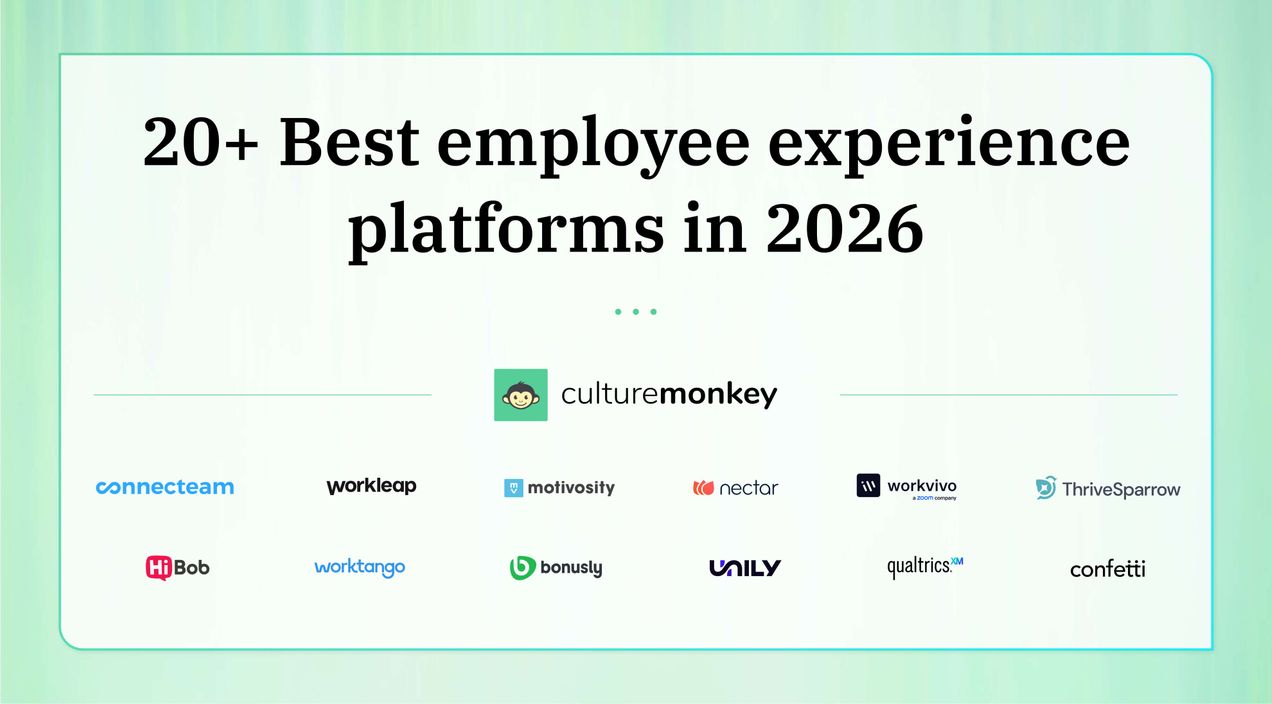Why bias in the workplace persists and how to break the cycle

Think of an old pair of glasses you’ve worn for years. They’ve got tiny scratches you barely notice anymore, but they subtly distort how you see the world. Over time, you stop realizing your view isn’t perfectly clear, it just feels normal.
Workplace bias works in much the same way.
It creeps in quietly, shaping how people are perceived or heard, often without anyone realizing it. From hiring decisions to daily interactions, these unseen “scratches” can blur fairness and limit potential.
Breaking the cycle means cleaning the lens, looking at policies, behaviors, and mindsets with fresh eyes to build a culture where everyone is truly seen for who they are.
- Explains what bias in the workplace is and why it often goes unnoticed.
- Discusses the negative impact of bias on morale, innovation, and retention. smooth flow.
- Lists common workplace biases and how they influence decisions.
- Suggests practical ways to identify and reduce bias, including feedback tools.
- Emphasizes the role of leadership and DEI tools in fostering inclusion.
What is a bias in the workplace?

Bias in the workplace refers to unfair treatment or assumptions based on characteristics like gender, race, or age. It affects hiring, promotions, and team dynamics, often unconsciously.
To combat it, organizations must implement inclusive practices, raise awareness, and foster open dialogue to create a fair and equitable work environment.
Bias in the workplace refers to the conscious and unconscious prejudices that influence how individuals are perceived and treated based on characteristics like gender, race, age, and appearance. These biases can hinder individual growth, weaken team dynamics, and limit innovation by stifling diverse perspectives.
They often show up in hiring, promotions, evaluations, and everyday interactions, such as favouring candidates with similar backgrounds. Unchecked bias leads to missed opportunities, reduced morale, and an inequitable work environment.
Addressing it requires more than good intentions—it takes structured action. Organizations should adopt unbiased hiring practices, provide mentorship opportunities, and offer regular bias awareness training. Equally important is fostering a culture where open conversations about bias are encouraged and inclusivity is the norm.
By building awareness and embedding fairness into daily operations, organizations can unlock the full potential of a diverse workforce, creating space where every employee can grow, contribute, and lead.
Why is recognizing workplace bias important?
Recognizing bias is the first step in managing bias in the workplace and creating a culture where every employee has a fair chance to succeed. When left unaddressed, bias silently shapes decisions, weakens morale, and obstructs growth.
- Improves decision-making at every level: Bias skews judgment in hiring, promotions, and evaluations. Recognizing it leads to more objective decisions and reduces bias treatment in the workplace.
- Enhances team collaboration and innovation: When employees feel excluded or stereotyped, they hesitate to contribute fully. A bias-aware environment encourages open collaboration and unlocks diverse thinking.
- Protects against legal and reputational risk: Unchecked bias and employment discrimination in the workplace can lead to complaints, lawsuits, and brand damage. Early recognition helps mitigate these risks.
- Drives equitable talent development: Without awareness, high-potential individuals may be overlooked due to personal characteristics. Recognizing bias ensures fair access to growth and leadership opportunities.
- Supports a culture of accountability: Acknowledging and addressing bias fosters transparency and trust. It shows that managing bias in the workplace is not just HR’s job—it's a shared responsibility across the organization.
The danger of bias in the workplace and when hiring

Bias is like a small tilt in a weighing scale; it seems minor at first, but it keeps delivering the wrong winner. In hiring and daily decisions, that tilt rewards familiarity over merit, hides real talent, weakens trust, and makes overcoming bias in the workplace harder. Let’s see the risks.
- Hidden talent loss: When bias at work favors look-alikes, strong candidates get ignored. Examples of workplace bias quietly reduce team diversity, limit innovation, slow hiring, and make it harder to build honest, global culture for everyone involved daily.
- Unseen decision drivers: Unconscious bias in the workplace makes hiring managers trust familiar schools, accents, or backgrounds. These implicit biases in the workplace patterns feel rational but block fair assessments and create repeating, unnoticed inequality in teams everywhere.
(Source: Gallup)
- Skewed hiring pipelines: When you do not plan how to prevent bias in the workplace, shortlists tilt toward one gender or group. That invites legal risk, slows DEI progress, and weakens employer brands in competitive markets worldwide today.
- Multiple bias sources: Different types of bias like affinity, confirmation, gender bias at work, and racial bias in the workplace rarely act alone. Together they nudge decisions away from skill and make evaluation frameworks inconsistent across teams and roles.
- Eroded employee trust: When people see examples of bias in workplace decisions, they stop applying for roles and stop referring to talent. Workplace bias signals that effort will not beat connections, pushing high performers to look elsewhere quietly and quickly.
- Higher business costs: Bias at work leads to rehiring, re-training, and longer time-to-fill because the first choice was not the best one. Over time leadership spends energy fixing avoidable mismatches instead of growing teams sustainably and strategically across functions.
- Missed improvement loops: Without data on unconscious bias types, leaders cannot compare locations, managers, or roles. That blocks overcoming bias in the workplace and keeps hiring reactive instead of data-led, structured, and transparent for candidates and current employees.
- Lack of shared definition: When teams never agree on what is bias in the workplace or which types of bias at work to monitor, implicit bias at work keeps slipping through interviews, performance talks, and promotion rounds repeatedly.
Bias doesn’t just affect decisions; it alters entire career trajectories. But before you can fix it, you need to know what drives it. Let’s break down how bias, stereotypes, and discrimination overlap—and how each fuels inequity at work.
Bias vs stereotype vs discrimination in the workplace

Understanding the distinctions between bias, stereotypes, and discrimination is crucial for fostering an inclusive and equitable workplace. Each of these concepts plays a unique role in shaping workplace dynamics, and recognizing them is the first step toward addressing and mitigating their impacts.
Each term plays a different role, but together, they create the invisible barriers employees face daily. To truly dismantle them, leaders must first learn how to detect bias early, before it becomes embedded in workplace culture or policy.
How to recognize and detect bias early in the workplace

Spotting bias is like catching a leak in the ceiling; the sooner you notice the damp patch, the cheaper the fix. In teams, early signs show up in who speaks, who’s promoted, and who quietly leaves, before it becomes workplace discrimination or affects retention. Data helps you see patterns you’d otherwise miss.
- Use anonymous pulse surveys: Short, frequent surveys surface bias in decision making, promotion bias, or pay gaps that people won’t say aloud. They help track sentiment by team, manager, or location and spotlight recurring unfair experiences quietly early.
- Audit hiring and performance data: Compare who gets hired, trained, or fast-tracked across gender, age, and teams. Sudden drop-offs signal bias in recruitment or reducing bias in performance appraisals is failing, even when policies look neutral on paper.
- Listen for microaggressions in comments: Repeated jokes, interruptions, or mispronounced names often reveal cultural bias at work. These everyday slips predict bigger issues like exclusion from projects, so coaching managers here prevents workplace discrimination and bias from escalating.
- Diversify decision panels: Having mixed interviewers or reviewers makes unconscious bias in the workplace easier to spot. Different viewpoints challenge affinity choices, highlight name bias, and make equitable workplace practices a habit instead of a one-time HR exercise.
- Review feedback language regularly: Vague notes like “not leadership material” often target the same groups. Pattern-based reviews help HR bias mitigation strategies catch prejudice early and push managers to give specific, skill-linked feedback for every employee in every cycle.
Recognizing that you have a bias and blind spots is essential to personal growth.
- Invite upward feedback for managers: Let employees rate fairness, recognition, and workload anonymously. Low scores around one leader show bias at work, not team weakness, giving HR a clear starting point for bias awareness training or coaching and accountability.
- Use employee feedback platforms: Tools that analyze open-text responses spot hidden trends across locations, roles, or demographics. They turn scattered complaints into evidence, helping leaders act quickly before bias in recruitment or promotions becomes visible attrition or public conflict.
Spotting bias is one thing—stopping it is another. The key lies in awareness and consistent training. Let’s see what kind of unconscious bias training actually works and how it can turn awareness into measurable behavior change.
Five overlooked areas where workplace bias exists

Reducing bias in the workplace requires organizations to examine their policies, culture, and daily practices to ensure fairness and inclusivity. Bias can creep into unexpected areas, affecting everything from hiring to company culture. Here are five critical areas where workplace bias and discrimination often arise—and how to address them.
1. Job posting
Bias in job postings starts with the language used. Words like “competitive” or “rockstar” may discourage women and minorities from applying, while listing unnecessary qualifications can exclude diverse candidates. Prejudice in the workplace often begins at this stage, limiting the talent pool and reinforcing systemic inequities.
To address this, use neutral and inclusive language in job descriptions. Tools like AI-based job scanners can help identify and remove biased phrasing. Emphasizing skills and competencies over rigid experience requirements broadens opportunities for underrepresented groups.
2. Marketing and communication
External and internal communications reflect company culture. When marketing materials and workplace messaging predominantly feature one demographic, it signals exclusion. Bias impact can also appear in performance reviews, where certain groups may receive less constructive feedback.
Companies should regularly audit their communication strategies to ensure representation and inclusivity. Providing diversity training for marketing teams and using diverse voices in content creation can help build a more welcoming environment.
3. Office food
Food offerings in the workplace may seem minor but can unintentionally exclude employees from different backgrounds. A menu that caters primarily to Western preferences or ignores dietary restrictions can alienate certain employees.
To foster inclusivity, companies should offer a variety of options that respect religious, cultural, and dietary needs. Gathering employee input through surveys can help ensure the menu reflects the diverse workforce.
4. Employee benefits
Workplace bias and discrimination often extend to employee benefits. Traditional benefit packages may favor specific demographics, such as parental leave policies that cater only to mothers or health plans that don’t cover LGBTQ+ needs.
Organizations should evaluate benefits through an inclusivity lens. Expanding parental leave to all caregivers, offering flexible work options, and ensuring comprehensive healthcare for all employees can create a fairer workplace.
5. Leadership
A lack of diversity in leadership reinforces workplace bias. When executives and managers come from similar backgrounds, it limits perspectives and decision-making. Employees from underrepresented groups may struggle to advance, leading to disengagement.
To break this cycle, companies should establish mentorship programs and implement unbiased promotion criteria. Encouraging leadership training for diverse employees and setting measurable diversity goals can create long-term change.
Bias isn’t always loud or obvious, it often hides in everyday routines and policies. The real challenge is knowing where to look. Let’s explore five unexpected areas where workplace bias quietly thrives, shaping who feels seen, supported, and included.
What are the examples of bias?

Biases are ingrained attitudes or stereotypes that can skew our perceptions and decision-making. Recognizing different types of bias is the first step toward creating an inclusive and equitable environment.
- Gender bias: Gender bias involves assumptions about a person’s abilities, interests, or behavior based solely on their gender. For example, women may be seen as too emotional for leadership, while men may be discouraged from roles in caregiving or HR. This affects promotions, leadership visibility, and how feedback is delivered—often more critical for women and more lenient for men.
- Racial bias: Racial bias manifests in judgments or assumptions made about someone due to their race or ethnicity. This can affect everything from hiring decisions to daily interactions, like assigning tasks, offering mentorship, or inviting someone to leadership tracks. Even name-based or accent-based judgments fall into this category.
- Age bias (Ageism): Age bias can impact both young and older employees. Older workers may be excluded from learning new technologies or projects due to perceived rigidity. Younger professionals might be overlooked for promotions or leadership roles because they are seen as “too inexperienced” regardless of their skills or results.
- Confirmation bias: When someone already believes a team member is “difficult” or “brilliant,” they’re more likely to notice actions that support that belief—and dismiss anything that contradicts it. This skews performance reviews, collaboration opportunities, and even team dynamics, leading to imbalanced recognition or criticism.
- Beauty bias: Also known as “lookism,” beauty bias results in favorable treatment of individuals perceived as attractive. They may receive more job offers, positive feedback, or client-facing roles—even if others have more relevant skills. This can demotivate team members and hinder diversity and inclusion.
- Affinity bias: People naturally gravitate toward those with whom they share similarities—whether it’s the same college, hometown, or hobbies. In the workplace, this can lead to forming “in-groups” and excluding others, reducing opportunities for diverse perspectives and reinforcing sameness in teams.
- Halo effect: If someone excels at one thing—say, public speaking—they might be seen as exceptional overall, even if they underperform in other areas. This can distort performance evaluations and team dynamics, giving some employees an unfair edge over others.
- Horn effect: The horn effect causes one negative trait—like disorganization or a single missed deadline—to cloud the overall judgment of someone’s ability or value. It often leads to micromanagement, lost trust, or exclusion from meaningful projects, even if the mistake was minor or isolated.
- Name bias: When resumes are judged based on how familiar or “ethnically neutral” a name sounds, it can result in highly qualified candidates being rejected before they even interview. Name bias reflects deep-seated stereotypes and contributes to the lack of diversity in hiring pipelines.
Knowing where bias exists isn’t enough, you also need to recognize how it shows up. From hiring decisions to casual conversations, here are the most common examples of bias that influence everyday behavior and workplace outcomes more than we realize.
Conscious bias vs Unconscious bias

Conscious bias and unconscious bias are distinct forms of biases that individuals may exhibit in various aspects of their lives, including the workplace. Understanding the differences between these biases is essential for fostering an inclusive and equitable environment.
Some biases are intentional, others happen automatically. Understanding this difference matters because it shapes how we respond.
Before tackling unconscious bias in the workplace, it’s important to see how both conscious and unconscious biases influence fairness and decision-making in subtle ways.
What are unconscious biases in the workplace?

Unconscious bias is like background music, you don’t realize it’s playing, but it subtly shapes your mood and choices. In workplaces, that music influences who we trust, hire, promote, and listen to. Recognizing these hidden rhythms is the first step toward fair, equitable workplace practices and better decision-making.
Unconscious biases in the workplace are automatic, deeply ingrained attitudes that influence how we perceive and treat others, often without realizing it. These biases affect hiring, evaluations, promotions, and teamwork.
Common types include affinity bias, stereotyping, halo/horn effect, attribution bias, and authority bias—all of which can hinder diversity, fairness, and innovation across an organization.
- Age bias at work: Older employees are often seen as less adaptable, while younger ones are viewed as inexperienced. This bias in decision making can sideline capable talent and reduce team learning across generations.
- Hiring bias: When recruiters unconsciously favor certain names, schools, or backgrounds, bias in recruitment creeps in. It limits diversity and inclusion in the workplace and narrows the talent pool available for key roles.
- Promotion bias: Managers may reward familiarity over performance, creating hidden barriers for overlooked employees. Promotion bias reinforces hierarchy rather than merit, slowing career growth and weakening trust in the system.
- Performance review bias: When feedback depends more on personality than results, reducing bias in performance appraisals becomes difficult. It discourages consistent performers and undermines credibility in company evaluation processes long term.
- Cultural bias at work: Workplace discrimination and bias often start with cultural misunderstandings. Over time, stereotypes affect collaboration, communication, and confidence, especially in global teams or cross-functional environments where context often gets misread.
- Gender bias and microaggressions: Subtle workplace microaggressions, interruptions, assumptions, or tone differences, shape daily experiences. They signal whose voice carries weight and whose doesn’t, quietly eroding inclusion and confidence across teams without open acknowledgment.
- Bias in decision making: Unconscious shortcuts guide many managerial choices. Without bias awareness training, these instinctive judgments harm objectivity and make HR bias mitigation strategies harder to implement across hiring, pay, and leadership planning processes.
- Structural bias patterns: Systems that lack equitable workplace practices repeat the same outcomes. Over time, unchecked bias damages culture, weakens accountability, and limits every organization’s ability to retain top talent and build truly inclusive environments.
Unconscious bias affects how we evaluate, reward, and collaborate without realizing it. But awareness is just the beginning. The next step is knowing how to take immediate action, especially in hiring, where bias has the power to shape your entire organization’s future.
How can unconscious bias undermine the success of a team?
Unconscious bias, though often unintentional, can significantly undermine the success of a team in various ways, impeding collaboration, hindering innovation, and contributing to a less inclusive work environment.
- Reduced diversity of thought: Bias limits the diversity of thought within a team. When team members unconsciously favor ideas that align with their own perspectives, it stifles innovation and creativity by excluding alternative viewpoints and solutions.
- Negative impact on morale: Unconscious bias can create an atmosphere of unfairness and inequality, negatively affecting team morale. Team members who perceive bias may disengage or feel undervalued, diminishing overall team cohesion and performance.
- Inequitable opportunities: Unconscious bias can lead to inequitable distribution of opportunities within a team. Certain individuals may be favored for projects, promotions, or skill development based on biases rather than merit, contributing to a less diverse and dynamic team.
- Undermined collaboration: Bias can erode trust and collaboration among team members. When individuals perceive that their contributions are undervalued or unfairly assessed, it hampers effective teamwork and the ability to leverage the collective skills of the team.
- Increased turnover: The presence of unconscious bias can lead to increased turnover as team members, particularly those who feel marginalized, may seek more inclusive work environments. This turnover disrupts team dynamics and can result in the loss of valuable talent.
- Impact on employee well-being: Unconscious bias can negatively affect the well-being of team members who experience bias. This can lead to stress, anxiety, and diminished job satisfaction, ultimately impacting individual and team performance.
- Strained interpersonal relationships: Bias can strain relationships among team members, fostering a tense and unproductive work environment. This strained interpersonal dynamic can impede effective communication and collaboration, hindering the team's overall success.
- Failure to recognize talent: Unconscious bias may result in the overlooking of talented individuals within the team. When biases influence recognition and reward systems, it can hinder the identification and cultivation of diverse skill sets, limiting the team's potential.
- Missed opportunities for innovation: Teams that succumb to unconscious bias may miss out on the benefits of diverse perspectives, hindering innovation. Embracing diverse ideas and experiences is crucial for staying competitive and adaptable in today's dynamic business landscape.
- Impaired decision-making: Unconscious bias can cloud judgment and lead to flawed decision-making processes within a team. When bias influences how information is interpreted or evaluated, it can result in suboptimal outcomes and missed opportunities for growth and success.
- Exclusion of marginalized voices: Unconscious bias may result in the exclusion of marginalized voices within the team. When certain individuals are consistently overlooked or marginalized due to bias, their valuable perspectives and contributions are not fully utilized, depriving the team of valuable insights and ideas.
Bias in recruitment and hiring: what you can do today
Recruitment is one of the most critical stages where workplace bias can take root. Left unchecked, it can exclude top talent and compromise diversity. Here’s how you can start overcoming bias in the workplace through practical, immediate actions.
- Anonymize resumes: Remove identifying details like name, gender, and graduation year to prevent assumptions and reduce unconscious bias in the workplace. This keeps the focus on relevant skills and experience.
- Use structured interviews: Ask all candidates the same questions and score their answers using a standardized rubric. This consistency limits conformity bias and ensures fairness throughout the process.
- Leverage technology for evaluation: Use AI or automated tools to analyze resumes and flag biased language. These tools can help eliminate manual errors and reduce workplace bias in early screening stages.
- Train your interviewers: Educate hiring teams about unconscious bias in the workplace so they can recognize their own assumptions and make more objective decisions.
- Diversify your interview panels: Include team members from different backgrounds to challenge groupthink and reduce conformity bias, resulting in more balanced and inclusive hiring outcomes.
The hiring process is often where bias starts, and where it can be stopped first. Once recruitment becomes fair and structured, attention must shift to what comes next: performance reviews and promotions, where hidden bias quietly influences advancement decisions.
Performance reviews and promotions: where bias creeps in
Even in organizations with the best intentions, implicit bias in the workplace often influences performance evaluations and promotion decisions. These subtle biases can hinder career growth for deserving employees and reinforce systemic inequities.
- Audit the review process: Regularly analyze performance review outcomes across teams, roles, and demographics to identify patterns that suggest conscious bias in the workplace. Spotting inconsistencies helps address root causes before they affect promotions.
- Standardize evaluation criteria: Create a clear, role-specific framework for evaluating performance. When everyone is assessed against the same benchmarks, it reduces subjectivity and helps in mitigating unconscious bias in the workplace.
- Incorporate multiple perspectives: Avoid relying solely on one manager’s feedback. Peer reviews, self-assessments, and 360-degree feedback help neutralize implicit bias in the workplace by offering a fuller picture of employee performance.
- Review feedback language: Bias can show up in how feedback is phrased. Watch for vague terms used disproportionately with certain groups, such as “not a good culture fit” or “lacks leadership presence.”
- Hold managers accountable: Track and report promotion trends by department or leader. Managers should be trained and evaluated on their ability to make equitable decisions and support inclusive advancement.
Bias doesn’t disappear after hiring, it evolves. It shapes evaluations, pay, and growth opportunities. The next step is learning how to tackle these implicit patterns directly and build systems that make fairness measurable, visible, and consistent across every team.
How to tackle implicit bias in the workplace?

Organizations can implement bias-awareness training, promote diverse hiring practices, and encourage a culture of openness and inclusivity where biases can be openly discussed and addressed.
Tackling unconscious bias in the workplace requires a concerted effort from both individuals and organizations. Here are some effective strategies to address and mitigate unconscious bias:
Tackling implicit bias in the workplace involves raising awareness, encouraging self-reflection, and implementing structured practices like blind resume reviews and objective evaluations.
Organizations should offer ongoing diversity training, promote inclusive policies, and create safe spaces for dialogue. Leadership must model inclusive behavior to foster a culture of accountability, openness, and continuous learning.
- Raise awareness: Start by educating employees about unconscious bias, its impact, and how it can influence decision-making. Conduct workshops, training sessions, or presentations to raise awareness and promote open discussions.
- Encourage self-reflection: Encourage employees to reflect on their own biases and how they may unconsciously affect their perceptions and behaviors. Creating a culture of self-awareness is essential in fostering change.
- Diverse hiring and promotion practices: Implement structured and standardized hiring processes that focus on skills, qualifications, and relevant experience. Include diverse interview panels to reduce the influence of individual biases.
- Blind resume review: Consider using blind resume reviews, where personal information such as name, gender, and age is redacted from resumes during the initial stages of the hiring process. This helps evaluate candidates solely based on their qualifications.
- Diversity training: Provide training for all employees. This should go beyond awareness-building to include actionable strategies for identifying and challenging biases.
- Establish inclusive policies: Develop and enforce inclusive policies that promote diversity and equity in the workplace. This may include policies related to flexible work arrangements, family leave, and equal pay.
- Set clear criteria for performance evaluation: Establish objective and measurable criteria for performance evaluations to reduce the influence of subjective biases. Train managers on how to conduct fair and unbiased evaluations.
- Promote employee engagement: Encourage employees to actively participate in decision-making processes and provide feedback on workplace practices. Involve employees in discussions about diversity and inclusion initiatives.
- Address microaggressions: Create a work culture where microaggressions are not tolerated. Empower employees to address and report instances of bias in a safe and supportive environment.
- Measure progress: Regularly assess and measure progress in tackling unconscious bias within the organization. Use metrics to track improvements in diversity, employee satisfaction, and inclusivity.
- Lead by example: Leaders play a crucial role in setting the tone for an inclusive workplace. They should actively demonstrate their commitment to addressing bias and promoting diversity.
- Encourage intersectional dialogue: Promote open conversations about intersectionality, acknowledging the complex interplay of various identities. This can help employees understand the unique challenges faced by individuals with intersecting marginalized identities.
- Establish affinity groups: Encourage the formation of affinity groups within the organization where employees with shared identities or experiences can connect and support each other. These groups provide a sense of community and can serve as valuable resources for feedback and initiatives.
- Implement continuous education: Incorporate ongoing education programs that address different types of unconscious bias over time. This ensures that employees remain aware and equipped to recognize and combat bias as they grow within the organization.
- Incentivize inclusive behaviors: Create incentives for employees and teams that actively demonstrate inclusive behaviors and contribute to reducing bias in the workplace. Recognizing and rewarding these efforts can reinforce the importance of inclusivity in the organizational culture.
How can your personal bias, behaviors, or attitudes affect mutual respect and communication with team members?
Even well-meaning professionals can unintentionally disrupt team harmony through subtle biases or unchecked attitudes. Here’s how personal bias impacts connection and collaboration:
- Alters tone and body language: Your unconscious assumptions can change how you speak or act toward certain team members, creating distance or discomfort. This can be an early sign of cultural bias in the workplace and affect team morale.
- Shapes who you listen to (or ignore): Personal bias can make you more attentive to ideas from people who “think like you” and unintentionally dismiss others. This highlights what is the primary consequence of in-group bias in the workplace—exclusion of diverse voices.
- Influences feedback and recognition: Your attitudes may lead you to praise or critique based on comfort or familiarity rather than merit. These are subtle workplace bias examples that can damage trust over time.
- Limits psychological safety: If team members sense prejudice in the workplace—even indirectly—they may withhold opinions or avoid collaboration, hurting creativity and problem-solving.
- Impacts clarity and empathy in communication: Bias can cloud your interpretation of tone or intent, leading to misunderstandings. Bias training in the workplace helps uncover these blind spots.
- Reinforces hierarchy or favoritism: Over time, unchecked behaviors create cliques or favoritism that marginalize others, reinforcing workplace divisions. Regular reflection and open dialogue are key to avoiding long-term damage.
How can acknowledging that you have biases help company culture?
Owning your bias is like turning on the lights in a cluttered room; the mess was always there, now you can see it, name it, and sort it properly. When leaders admit blind spots first, people follow, and culture shifts from defensive to developmental learning for everyone involved across teams and levels.
- Opens honest dialogue: Admitting unconscious bias in the workplace tells employees it is safe to name patterns openly. That transparency reduces denial, shows the real impact of bias in the workplace, and invites shared responsibility for fixing it.
- Breaks the silence around discrimination: When leaders own their blind spots, bias and discrimination in the workplace stop feeling personal or risky. People can address behaviour, not people, which makes correction faster and protects inclusion goals from quiet resistance.
- Turns judgment into curiosity: Naming conscious bias in the workplace shows that prejudice in the workplace can be unlearned. Teams begin asking why a choice was made, who was missing, and how to improve the decision next time together.
- Exposes subtle stereotypes: Talking openly reveals how social stereotypes, beauty bias, or name bias slip into hiring or praise unfairly. Once visible, HR can redesign touchpoints so talent is judged on skill, not surface signals or cultural familiarity.
- Models learning culture: When managers admit bias first, it normalizes bias awareness training for everyone in the company. Teams see inclusion as a skill, not punishment, which strengthens culture and makes future conversations about fairness far easier to have.
- Improves everyday decisions: Acknowledgment makes people slow down before choosing, promoting, or reviewing others at work. That pause reduces rushed bias in evaluations and keeps culture tied to values, not convenience, especially in fast-moving teams with many decisions.
What role does emotional intelligence play in reducing bias?
Emotional intelligence (EQ) is a powerful tool to help recognize and reduce unconscious bias in the workplace. Here’s how it plays a role in addressing different types of biases fairly:
- Boosts self-awareness: Emotional intelligence helps individuals become more aware of their own beliefs, reactions, and patterns of thinking. This self-awareness is essential in recognizing unconscious bias in the workplace before it influences hiring, evaluations, or collaboration.
- Encourages empathy: With stronger emotional intelligence, employees become more attuned to how others think and feel. This empathy reduces bias types like stereotyping or exclusion based on gender, race, or other traits. Understanding others’ perspectives allows for more thoughtful responses and fosters an inclusive mindset that challenges different types of biases.
- Improves decision-making: Emotionally intelligent individuals pause to question their assumptions, especially when evaluating performance or resolving conflicts. This minimizes bias at work by reducing knee-jerk judgments rooted in common bias types such as the halo effect or confirmation bias.
- Promotes inclusive communication: EQ helps people listen actively and engage without prejudice. It encourages consideration of viewpoints across various teams, helping prevent kinds of bias like ignoring input from quieter or underrepresented voices. This openness strengthens team cohesion and fairness.
- Fosters reflection and growth: Workplaces that prioritize EQ create space for people to reflect on their own actions and attitudes. By acknowledging different types of bias and examples openly, employees are more likely to learn from mistakes and become allies in creating an inclusive culture.
How can you reduce bias, prejudice and discrimination?

Reducing bias, prejudice, and discrimination requires a multifaceted approach that involves individual actions, organizational initiatives, and broader societal efforts. Here are some additional strategies to complement the ones mentioned earlier:
Reducing bias, prejudice, and discrimination requires inclusive practices like mentorship programs, cultural competency training, and intergroup collaboration. Using standardized evaluation tools, analyzing workforce data, and supporting employee resource groups also help.
Promoting diverse leadership and addressing bias in AI systems ensures fairness. Inclusive language and public success stories further reinforce equity across the organization.
- Promote intergroup contact: Encourage opportunities for employees from different backgrounds to interact and collaborate. Working together on projects or participating in team-building activities can break down barriers and foster understanding between individuals.
- Mentorship and sponsorship programs: Establish mentorship and sponsorship programs that connect individuals from underrepresented groups with more experienced colleagues. These programs can help provide guidance, support, and career advancement opportunities to those who may face systemic barriers.
- Diverse leadership development: Create tailored leadership development programs that cater to the needs and challenges faced by individuals from diverse backgrounds. Investing in their growth and professional advancement can lead to a more diverse leadership team.
- Checklists and evaluation rubrics: Implement standardized checklists and evaluation rubrics for hiring, promotions, and performance evaluations. These tools can help reduce subjective biases and ensure a more objective and consistent assessment process.
- Collect and analyze data: Regularly collect and analyze demographic data on hiring, promotions, and employee turnover to identify potential disparities. Use this data to inform targeted diversity and inclusion strategies.
- Employee resource groups (ERGs): Support the creation of Employee Resource Groups where individuals from similar backgrounds or with shared interests can connect, share experiences, and advocate for change within the organization.
- Cultural competency training: Offer cultural competency training to employees to enhance their understanding of different cultures and perspectives. This can help increase empathy and reduce harmful stereotypes.
- Address biases in artificial intelligence (AI) and technology: Be vigilant about potential biases in AI algorithms used in hiring, performance evaluations, or decision-making processes. Regularly audit and update these technologies to ensure fairness and equity.
- Inclusive language and communication: Encourage the use of inclusive language in workplace communications and interactions. Avoiding gender-specific language, for example, can help create a more inclusive and welcoming environment.
- Publicize success stories: Celebrate success stories of employees from diverse backgrounds to highlight the value of inclusivity and create positive role models for others.
The ways managers can work to reduce stereotyping include

Reducing stereotyping in the workplace is a crucial responsibility for managers, as their influence significantly shapes the organizational culture. By implementing specific strategies, managers can work towards fostering an environment that is free from stereotypes and promotes diversity and inclusion.
- Lead by example: Managers play a pivotal role in setting the tone for acceptable behavior within the team. By demonstrating inclusive behavior and embracing diversity in their decision-making, managers serve as role models for the entire workforce.
- Conduct unbiased performance evaluations: Provide training for managers on conducting fair and unbiased performance evaluations. This ensures that assessments are based on objective criteria, minimizing the impact of stereotypes on professional advancement.
- Promote mentorship programs: Establish mentorship programs that connect employees from diverse backgrounds. Mentorship fosters understanding, breaks down stereotypes, and provides opportunities for professional growth under the guidance of experienced colleagues.
- Address microaggressions promptly: Managers should promptly address any microaggressions observed within the team. This involves actively listening to concerns, investigating incidents, and taking appropriate corrective actions to maintain a respectful and inclusive workplace.
- Foster a culture of inclusivity: Actively foster a culture that celebrates diversity and values each team member for their unique contributions. Managers can organize events, recognize cultural awareness days, and promote inclusive language to create an inclusive work environment.
- Measure and monitor progress: Implement metrics to measure progress in reducing stereotyping within the team. Regularly monitor the effectiveness of initiatives and adjust strategies accordingly to ensure a continuous commitment to diversity and inclusion.
What can HR leaders do to address unconscious bias in the workplace?

HR leaders play a critical role in identifying and reducing unconscious bias to foster a more inclusive and equitable work environment. Implementing targeted strategies helps create a culture that values diversity, equity, and belonging.
HR leaders can reduce unconscious bias by implementing blind recruitment, providing ongoing diversity training, supporting employee resource groups (ERGs), reviewing and updating inclusive policies, and partnering with DI experts.
These strategies help create a fair, inclusive workplace that supports equity, belonging, and diverse perspectives while promoting consistent, unbiased decision-making throughout the organization.
- Implement blind recruitment: Remove identifying information from resumes to focus solely on skills and qualifications, reducing bias in hiring decisions. Standardized hiring processes and structured interviews further ensure fair candidate evaluations.
- Encourage diversity training: Provide workshops that help employees recognize and challenge unconscious bias in daily interactions and decision-making. Continuous training ensures long-term awareness and commitment to inclusivity.
- Support employee resource groups (ERGs): Offer a platform for underrepresented groups to share experiences, build community, and promote inclusivity. Providing executive sponsorship and funding for ERGs can enhance their impact and reach.
- Review and update company policies: Ensure workplace policies are free from discriminatory language and address the diverse needs of employees. Regular audits help identify gaps and ensure policies evolve with workforce diversity.
- Partner with diversity and inclusion experts: Work with external consultants and organizations to gain insights and implement best practices for reducing bias. Leveraging external perspectives can bring fresh solutions to ingrained workplace challenges.
Unconscious bias training that actually works

Good unconscious bias training is like updating your GPS; the route was fine once, but traffic, detours, and new roads make old directions risky. Workplaces change fast, so training has to move from awareness to repeatable habits that reshape daily decisions. That’s how teams stop bias before it shows up in outcomes.
- Start with real scenarios, not theory: Good bias awareness training uses your own hiring, promotion, and feedback examples. People recognize themselves, accept blind spots faster, and connect it to reducing bias in performance appraisals and everyday decisions at work.
- Make it role-specific: Finance, HR, engineering, and sales see bias differently. Training that shows bias in recruitment, cultural bias at work, or promotion bias for each team sticks better and leads to equitable workplace practices across locations consistently.
- Blend learning with data: Pair sessions with survey findings, exit themes, or performance review audits. When people see workplace discrimination and bias patterns in numbers, they take HR bias mitigation strategies seriously and change daily habits faster at scale.
- Include practice and reflection: Ask people to rewrite feedback, redesign an interview, or role-play workplace microaggressions. Doing the fix makes unconscious choices visible and supports diversity and inclusion in the workplace instead of leaving biased knowledge in slides.
- Train managers first: Bias in decision making shows most in performance reviews, pay, and project staffing. When managers learn first, reducing bias in performance appraisals becomes easier and teams see bias training as useful, not compliance across functions.
- Measure behaviour after training: Track hiring bias, promotion bias, and language in reviews monthly. If numbers don’t shift, repeat coaching. Real unconscious bias training changes outcomes, not just awareness, and helps leadership prove equitable workplace practices over time.
The hidden cost of bias at work: Attrition, lawsuits & lost innovation
While bias might not always be visible, its consequences ripple through the workplace—quietly eroding morale, trust, and performance. Here’s how unaddressed bias takes a heavy toll on both people and profits:
- High employee turnover: When employees feel sidelined by preconceived notions at work, especially those from underrepresented groups, they’re more likely to leave—taking their skills, experience, and potential with them. Addressing bias in the workplace early helps improve retention.
- Legal and reputational risks: Unchecked bias can lead to lawsuits and formal complaints. These aren’t just legal threats to bias management—they damage trust, employer branding, and team morale.
- Stifled innovation and collaboration: When some voices are consistently overlooked due to unconscious assumptions, it kills diverse thinking. Mitigating unconscious bias in the workplace ensures all ideas are heard, fueling creativity and problem-solving.
- Low engagement and productivity: Bias can create silent disengagement, where employees do just enough to get by. Overcoming bias in the workplace requires leaders to build a culture where every contribution feels seen and valued.
- Missed leadership potential: Biases—examples include assuming someone is “too quiet” for leadership, prevent capable individuals from advancing. Knowing how to eliminate bias helps surface hidden talent and promote more inclusive leadership development.
Training programs that actually reduce bias
Bias training often falls short because it’s too generic or theoretical. To effectively tackle bias at workplace, programs must be behavior-driven, context-specific, and embedded into the company’s operations—not just compliance checkboxes.
- Use department-specific content: Generic training overlooks the nuances of different teams. Tailoring content for engineering, sales, or HR helps uncover the specific ways workplace discrimination and bias show up in those environments, making interventions more relevant.
- Involve participants in outcome design: Rather than passively attending, employees should co-create solutions during training. This collaborative approach increases accountability and directly ties the training to how people act when addressing bias in the workplace.
- Analyze decision-making patterns post-training: Track real-world decisions—like hiring or performance scoring—before and after training. This reveals whether the program is truly influencing how people are addressing bias in the workplace in practice.
- Replace "awareness" with habit-building: Training should focus on building new habits using behavioral nudges and microlearning, not just sharing definitions of prejudice in the workplace.
- Make managers run the sessions:Instead of external consultants, have managers lead workshops. This reinforces ownership and sends a clear message: knowing how to address bias in the workplace isn’t optional—it’s a leadership skill.
Role of employee feedback survey software in unconscious bias training
Unconscious bias can be difficult to identify, making it crucial for organizations to use employee feedback survey software to gain insights into workplace perceptions and experiences. This software helps track bias-related issues, measure progress, and drive meaningful change through structured feedback collection.
Employee feedback survey software supports unconscious bias training by uncovering hidden biases, providing data-driven insights, and measuring training effectiveness. It encourages open communication, allows for customized training based on employee needs, and promotes long-term cultural change.
By collecting anonymous, structured feedback, organizations can track progress and continuously improve their efforts to reduce bias in the workplace.
- Identifies hidden biases: Employees can anonymously share their experiences, helping organizations detect patterns of unconscious bias that may not be immediately visible.
- Provides data-driven insights: Analyzing survey results enables HR teams to assess trends and understand how bias affects workplace culture, hiring, and promotions.
- Measures training effectiveness: Organizations can track changes in employee perceptions before and after unconscious bias training, ensuring continuous improvement.
- Encourages open communication: Surveys create a safe space for employees to express concerns about bias, fostering transparency and accountability.
- Customizes learning programs: Feedback helps organizations tailor unconscious bias training to specific challenges faced by employees, making sessions more relevant and impactful.
- Promotes long-term change: Regular surveys ensure that unconscious bias training is not a one-time event but an ongoing process embedded in workplace culture.
Conclusion
Bias in the workplace isn’t just about fairness, it directly impacts trust, innovation, and retention. When certain voices are unintentionally favored or overlooked, teams lose the diversity of thought that fuels better decisions and engagement. Recognizing bias is the first step, but acting on it requires consistent feedback, transparency, and accountability. That’s where CultureMonkey helps.
With CultureMonkey’s employee feedback and engagement platform, organizations can uncover hidden bias patterns through real-time analytics, pulse surveys, and sentiment tracking. Leaders gain clear insights into how employees actually feel, helping them build inclusive systems where every opinion carries weight. By listening actively and acting fairly, companies don’t just reduce bias, they create workplaces where everyone feels respected, valued, and heard.
Book a demo with CultureMonkey.
FAQs
1. Is bias at the workplace illegal?
Many forms of workplace bias are illegal when they become employment discrimination, including hiring, pay, and promotion decisions. Even when unconscious biases occur, they can still affect judgment and trigger unfair judgments. Addressing perception bias, and affinity bias helps avoid unconscious bias, narrow the gender pay gap, and create an inclusive workplace environment built on clear criteria and concrete evidence.
2. What is workplace bias, and how does it manifest in the workplace?
Workplace bias appears when a person judges or treats colleagues based on stereotypes rather than concrete evidence. Common unconscious bias examples include perception bias, affinity bias, authority bias, and recency bias. Because the human brain uses shortcuts, unconscious biases occur quickly and subtly, shaping the interview process, performance reviews, and opportunities for younger employees.
3. How can employees respond to workplace bias?
Document incidents with dates, witnesses, and outcomes, then report discriminatory practices through formal channels. Seek support from trusted managers, ERGs, or external advisors. Learn how unconscious bias influences interactions so you can avoid affinity bias, avoid conformity bias, and limit intuition bias. Ask for structured criteria in the interview process and evaluations.
4. How can diversity and inclusion initiatives help combat workplace bias?
Strong diversity and inclusion programs teach how unconscious bias distorts decisions and provide practical tools to avoid unconscious bias. They standardize hiring, widen outreach to minority groups, and review language that can affect judgment. Rotating interview panels curb affinity bias and authority bias. Transparent pay reviews help close the gender pay gap.
5. Can bias be eliminated from the workplace?
Probably not completely, because the human brain relies on shortcuts that sometimes cause unconscious biases to occur. However, organizations can reduce them. Publish criteria, audit outcomes, and train people to avoid affinity bias, and recency bias. Encourage feedback that challenges intuition bias and helps avoid conformity bias. Over time, measurement, and accountability cut unfair judgments and improve higher job satisfaction.
6. How can hiring practices be adjusted to reduce bias?
Use blind resume reviews, skill-based tasks, and standardized scoring rubrics. Rotate diverse interview panels to avoid affinity bias, perception bias, and authority bias. Slow decisions so intuition bias does not affect judgment. Track funnel data for job applicants to find patterns harming younger employees or minority groups. Share criteria with candidates.
7. What are the best strategies to train managers against bias?
Make training practical, recurring, and tied to decisions. Show unconscious bias examples from real hiring and review data. Coach managers to avoid conformity bias and affinity bias, and to challenge authority bias respectfully. Practice rewriting feedback, evaluating interview process notes, and checking for recency bias. Reinforce habits with nudges, peer reviews, and metrics.
8. How can companies measure progress in reducing workplace bias?
Measure inputs and outcomes. Track hiring, promotions, compensation, and exit rates by level and demographic. Survey teams about fairness, belonging, and how unconscious bias appears. Review interview process notes for perception bias, authority bias, and recency bias. Compare ratings against results to find where a positive impression repeatedly outweighs concrete evidence.
9. How do we detect bias early?
Start with patterns, not accusations. Analyze language in reviews, meeting airtime, and who gets stretch work. Anonymous surveys reveal where unconscious biases occur. Watch for authority bias, affinity bias, and recency bias in shortlists. Involve diverse reviewers to avoid conformity bias. Offer safe reporting channels and immediate coaching. Early detection prevents negative workplace culture from taking root.
10. Are bias training effective?
Yes, when designed well. Effective programs explain why unconscious bias is important, then give tools to avoid unconscious bias in daily choices. They teach how unconscious bias shapes the interview process and evaluations, countering intuition bias and perception bias. Practice with real cases, and follow-up metrics. Over time, these routines reduce unfair judgments and raise higher job satisfaction across teams.








